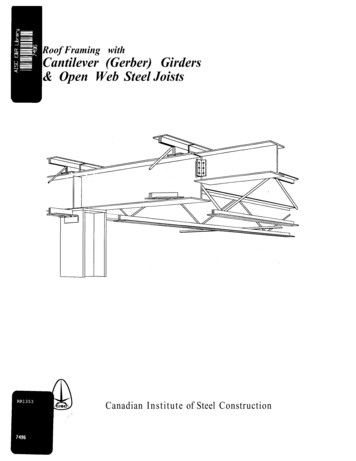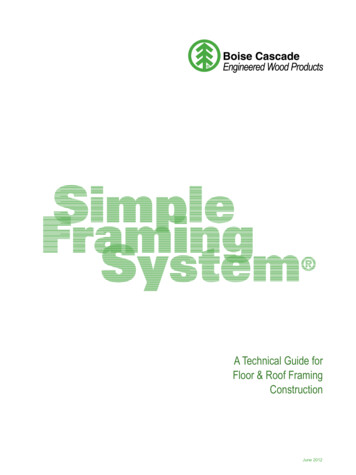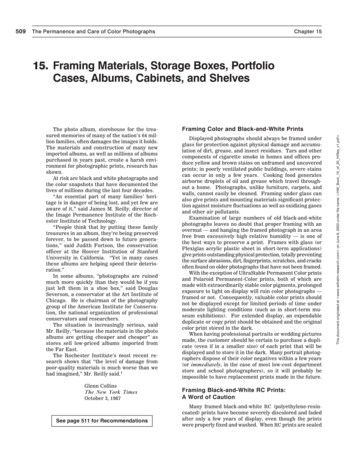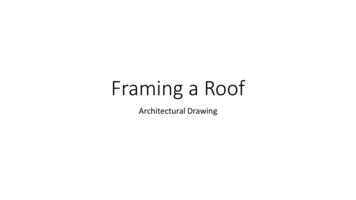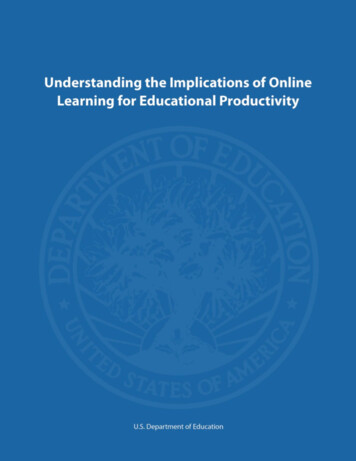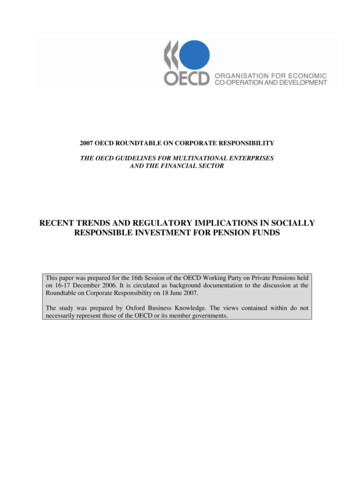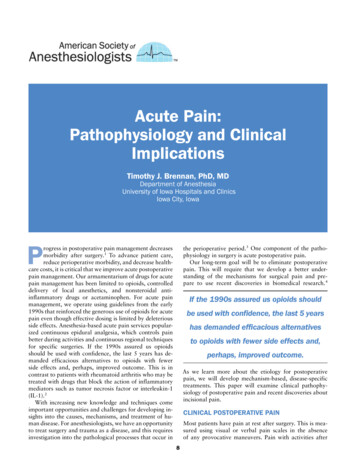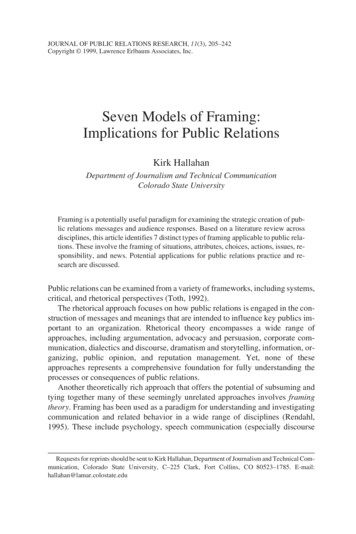
Transcription
JOURNAL OF PUBLIC RELATIONS RESEARCH, 11(3), 205–242Copyright 1999, Lawrence Erlbaum Associates, Inc.Seven Models of Framing:Implications for Public RelationsKirk HallahanDepartment of Journalism and Technical CommunicationColorado State UniversityFraming is a potentially useful paradigm for examining the strategic creation of public relations messages and audience responses. Based on a literature review acrossdisciplines, this article identifies 7 distinct types of framing applicable to public relations. These involve the framing of situations, attributes, choices, actions, issues, responsibility, and news. Potential applications for public relations practice and research are discussed.Public relations can be examined from a variety of frameworks, including systems,critical, and rhetorical perspectives (Toth, 1992).The rhetorical approach focuses on how public relations is engaged in the construction of messages and meanings that are intended to influence key publics important to an organization. Rhetorical theory encompasses a wide range ofapproaches, including argumentation, advocacy and persuasion, corporate communication, dialectics and discourse, dramatism and storytelling, information, organizing, public opinion, and reputation management. Yet, none of theseapproaches represents a comprehensive foundation for fully understanding theprocesses or consequences of public relations.Another theoretically rich approach that offers the potential of subsuming andtying together many of these seemingly unrelated approaches involves framingtheory. Framing has been used as a paradigm for understanding and investigatingcommunication and related behavior in a wide range of disciplines (Rendahl,1995). These include psychology, speech communication (especially discourseRequests for reprints should be sent to Kirk Hallahan, Department of Journalism and Technical Communication, Colorado State University, C–225 Clark, Fort Collins, CO 80523–1785. E-mail:hallahan@lamar.colostate.edu
206HALLAHANanalysis and negotiation), organizational decision making, economics, healthcommunication, media studies, and political communication.The premise of this article is that framing theory provides a potentially usefulumbrella for examining what occurs in public relations. In addition to a rhetoricalapproach that focuses on how messages are created, framing is conceptually connected to the underlying psychological processes that people use to examine information, to make judgments, and to draw inferences about the world around them.This linkage is missing in many of the other rhetorical frameworks. Moreover,framing phenomena operate across levels of analysis (J. M. McLeod, Pan, &Rucinski, 1994; Pan & McLeod, 1991), making framing theory applicable at theintrapersonal, interpersonal, group, organizational, interorganizational, and societal levels in which public relations influence attempts operate.This article begins by defining framing and its linkages to psychological processing. It then proceeds to identify seven distinct types or models of framing thatmight be applicable to public relations practice, depending on the circumstances. Itconcludes by suggesting some specific applications as well as directions for futureresearch.FRAMING DEFINEDAs a foundation, it is important to recognize that public relations work fundamentally involves the construction of social reality (Berger & Luckmann, 1966;Tuchman, 1978). The constructivist approach to communication draws on ideasfrom the symbolic interactionism school of sociology (Blumer, 1971). Symbolicinteractionism rejects attempts to examine human behavior in terms of instinct, external forces, or the structural–functional explanations that predominated early sociological thinking. Instead, human behavior is thought to result from how peopleinteract and their use of symbols to create meaning. Constructionists contend thatrepresentations of objects or problems in people’s minds vary from the corresponding actual objects or conditions on which they are based. More important, constructionists contend that people act based on these perceptions, or what Lippmann(1922) deftly described as “the pictures inside our heads,” rather than “objective reality” (p. 3).Public relations workers have been referred to pejoratively as “imagemakers”and “spin doctors”—labels that only partially portray their important role in constructing social reality. Indeed, public relations counseling involves defining reality for organizations by shaping organizational perspectives about the outsideworld—a process also termed enactment (Weick, 1969). Similarly, outbound public relations communications involve attempts to define reality, at least as it relatesto client organizations, for the many publics on whom the organization depends.This construction process might be dismissed as manipulation. However, because
FRAMING AND PUBLIC RELATIONS207defining reality is the very essence of communication, constructionists would argue that the process is neither inherently good nor bad.Framing is a critical activity in the construction of social reality because it helpsshape the perspectives through which people see the world. Although public relations practitioners commonly refer to framing effective messages (Duhé & Zoch,1994) in the same way that a builder frames a house from the bottom up, the framing metaphor is better understood as a window or portrait frame drawn around information that delimits the subject matter and, thus, focuses attention on keyelements within. Thus, framing involves processes of inclusion and exclusion aswell as emphasis. Entman (1993) summarized the essence of framing processeswith the following:Framing essentially involves selection and salience. To frame is to select some aspects of perceived reality and make them more salient in the communicating text, insuch a way as to promote a particular problem definition, causal interpretation,moral evaluation and/or treatment recommendation for the item described. Frames,then, define problems—determine what a causal agent is doing and costs and benefits,usually measured in terms of cultural values; diagnose causes—identify the forcescreating the problem; make moral judgments—evaluate causal agents and their effects; and suggest remedies—offer and justify treatments for the problem and predicttheir likely effects. (p. 55)Implicitly, framing plays an integral role in public relations. If public relations isdefined as the process of establishing and maintaining mutually beneficial relationsbetween an organization and publics on whom it depends (Cutlip, Center, & Broom,1995), the establishment of common frames of reference about topics or issues ofmutual concern is a necessary condition for effective relations to be established.How Framing WorksAs a property of a message, a frame limits or defines the message’s meaning byshaping the inferences that individuals make about the message. Frames reflectjudgments made by message creators or framers. Some frames represent alternative valencing of information (i.e., putting information in either a positive or negative light, or valence framing). Other frames involve the simple alternative phrasing of terms (semantic framing). The most complex form of framing is storytelling(story framing). Story framing involves (a) selecting key themes or ideas that arethe focus of the message and (b) incorporating a variety of storytelling or narrativetechniques that support that theme. Pan and Kosicki (1993), for example, suggestedthat framing can be evidenced in a series of structures within a message. These include syntactical structures, stable patterns of arranging words and phrases in a text(see also T. A. van Dijk, 1988); script structures, the orderly sequencing of events
208HALLAHANin a text in a predictable or expected pattern; thematic structures, the presence ofpropositions or hypotheses that explain the relations between elements within atext—including the presence of words such as “because,” “since,” and “so”; andrhetorical structures that subtly suggest how a text should be interpreted. Rhetorical devices can include metaphors and similes, familiar exemplars and illustrations,provocative language and descriptors, catchphrases, and visual imagery (Gamson& Modigliani, 1989).Framing operates by biasing the cognitive processing of information by individuals. At least two mechanisms to explain the process are found in the literature. Onesuggestion is that framing operates by providing contextual cues that guide decisionmaking and inferences drawn by message audiences. Drawing on their earlier workon the concept, Kahneman and Tversky (1979) suggested that the simple positive-versus-negative framing of a decision operates as a cognitive heuristic orrule-of-thumb that guides decisions in situations involving uncertainty or risk. Negative reactance to losses or risks is consistent with other findings in the impressionformation literature that suggest negative information is weighted more heavily thanpositive information (Hamilton & Zanna, 1972) and is more attention-getting(Pratto & John, 1991). It is also consistent with motivational theories that people actto protect themselves. More recent evidence for this heuristic explanation was provided by S. M. Smith and Petty (1996), who used the elaboration likelihood model(Petty & Cacioppo, 1986) to suggest that negative framing might serve as a peripheral cue in processing. Specifically, negative framing might prompt people to thinkmore about a message (i.e., engage in more effortful processing or message elaboration). This finding is consistent with research that suggests that message framing effects vary by level of involvement (Maheswaran & Meyers-Levy, 1990).The second mechanism through which framing operates is priming. Knowledge is thought to be organized in human memory in cognitive structures orschemas, which operate as constraints on the arrangement and interpretation of situations and events (Bartlett, 1932; Fiske & Taylor, 1984; Markus & Zajonc, 1985;Neisser, 1967). Alternatively, schemas have been conceptualized as categories(hierarchial structures), as prototypes (idealized representations of objects withinparticular classes), and as scripts (expected scenarios for events).Although the schematic organization of memory has been challenged (Alba &Hasher, 1983), the notion jibes with at least three of the major models that describememory in terms of associative networks (Anderson, 1976), storage bins (Wyer &Srull, 1986), and distributed memory models (McClelland & Rummelhart, 1985).Regardless of the specific model, researchers agree that schematic processing entails people using association and expectation to make inferences about events andto impute meaning not manifested in the message itself. Significantly, some researchers use “frame” synonymously with schema to delimit which memory nodesare associated with a particular topic in memory (see Barsalou, 1992; Biocca,1991; Lawson, 1998).
FRAMING AND PUBLIC RELATIONS209Framing affects cognitive processing by selectively influencing which memorynodes, or sets of memory traces organized as schemas, are activated to interpret aparticular message. Priming effects can be conscious, such as when a person purposefully uses message cues to attempt to retrieve stored knowledge from memory. Priming effects also can be unconscious or automatic, such as when a personcategorizes a topic or message during the pre-attention phase of processing andthen processes information using rules that are considered appropriate in the situation (Bargh, 1988; Higgins, Bargh, & Lombardi, 1985).SEVEN MODELS OF FRAMINGAlthough a theoretically rich and useful concept, framing suffers from a lack of coherent definition. An exhaustive literature search suggests the existence of morethan 1,000 citations about framing in the academic literature. Framing has beenadopted as a textual, psychological, and socio-political construct. Depending onthe circumstances, the meaning of framing varies based on the research question,the level of analysis, or the underlying psychological process of interest. Entman(1993) characterized framing as a “fractured” paradigm that lacks clear conceptualdefinitions and a comprehensive statement to guide research. Other researchershave called for developing a more integrated approach that clarifies the framingconcept within various domains (e.g., Brosius & Eps, 1995; Levin, Schneider, &Gaeth, 1998; Pan & Kosicki, 1993; Scheufele, 1999; Yows, 1995). Thus, to use theconstruct in research requires careful explication (Chaffee, 1991).Framing’s ostensible weakness also is one of the concept’s inherent strengths.Framing’s emphasis on providing context within which information is presentedand processed allows framing to be applied across a broad spectrum of communication situations. An examination of the literature across disciplines suggests atleast seven models of framing that have potential application to public relations.By examining these alternative conceptualizations, it is possible for researchersand practitioners to understand the usefulness of the framing concept, to apply it inpractice, and to pursue a systematic research agenda about framing as it might beapplied to public relations. This article is a small step toward that goal. The sevenmodels involve the framing of situations, attributes, choices, actions, issues, responsibility, and news. Each of the seven models are summarized in Table 1 anddiscussed next.FRAMING OF SITUATIONSResearchers from anthropology and sociology were the first to examine communication using a framing paradigm. Their legacy of using framing to describe how re-
210HALLAHANTABLE 1Typology of Seven Models of Framing Applicable to Public RelationsWhat is onsibilityNewsDescriptionKey SourcesRelationships between individuals in situations found ineveryday living and literature. Framing of situationsprovides structure for examining communication.Applies to discourse analysis, negotiation, and otherinteractions.Characteristics of objects and people are accentuated,whereas others are ignored, thus biasing processing ofinformation in terms of focal attributes.Bateson (1972), Goffman(1974), Putnam &Holmer (1992),Tannen (1993)Posing alternative decisions in either negative (loss) orpositive (gain) terms can bias choices in situationsinvolving uncertainty. Prospect theory suggests peoplewill take greater risks to avoid losses than to obtaingains.In persuasive contexts, the probability that a person willact to attain a desired goal is influenced by whetheralternatives are stated in positive or negative terms.Social problems and disputes can be explained inalternative terms by different parties who vie for theirpreferred definition a problem or situation to prevail.Individuals tend to attribute cause of events to eitherinternal or external factors, based on levels of stabilityand control. People portray their role in eventsconsistent with their self-image in ways that maximizebenefits and minimize culpability. People attributecauses to personal actions rather than systemicproblems in society.Media reports use familiar, culturally resonating themesto relay information about events. Sources vie for theirpreferred framing to be featured through frameenterprise and frame sponsorship.Ghanem (1997), Levin,Schneider, & Gaeth(1998), McCombs &Ghanem (1998), Ries& Trout (1981),Wright & Lutz (1993)Bell, Raiffa, & Tversky(1988), Kahneman &Tverksy (1979, 1984),Levin, Schneider, &Gaeth (1998)Maheswaran &Meyers-Levy (1990),Smith & Petty (1996)Best (1995), Gamson &Modigliani (1989),Snow & Benford(1988, 1992)Iyengar (1991), Iyengar& Kinder (1987),Kelley (1967, 1972a),Protess et al.(1991),Wallack, Dorfman,Jernigan, & Themba(1993)Gamson (1984), Gamsonet al. (1992), Ryan(1991)ality is constructed through language and the structure of interactions among people can be labeled as relational or situational framing.Anthropologist Gregory Bateson (1972) is credited as the originator of situational framing theory. He defined a psychological frame as “a spatial and temporalbounding of a set of interactive messages” (p. 191). According to Bateson, the participants’ understanding of the interaction in which they engage—including theirroles and the rules to be followed—operate as a form of metacommunication (i.e.,communication about communication that guides the process). Sociologist Erving
FRAMING AND PUBLIC RELATIONS211Goffman (1974) later expanded the notion and described framing as “the definition of a situation built up in accordance with principles of organization thatgovern events—at least social ones—and our subjective involvement in them” (p.10). Goffman defined a frame as a “schemata of interpretation” that provides acontext for understanding information and enables individuals to “locate, perceive, identify and label” (p. 21). In his classic work on frame analysis, Goffmanidentified various processes involved. Of these, three of the most important werekeying, bringing into focus particular aspects of everyday life by recreating past interactions; anchoring, the rooting of ideas in deeper frames of meaning; and fabrication, the recasting of certain dimensions of experience so they are made salientwithin a situation or interaction. Linguists and others in related disciplines havedrawn on Bateson and Goffman and have applied frame analysis to studies that analyze discourse (e.g., Tannen, 1986, 1993), language (Hofling, 1987), and literarystorytelling (Hufford, 1995).Two of the most important research domains relevant to public relations inwhich situation framing has been investigated involve organizational behaviorand negotiation. Culbert and McDonough (1990), for example, described (situational) framing as the process by which managers at all levels attempt to imposetheir version of reality on situations. Hirsch (1986) argued that normative framing has facilitated acceptance of once-disdained business practices, such as hostile takeovers. In the same way, organizational framing (i.e., the use of framesby organizations in its discourse) has been used to examine contemporary problems. Examples include sexual exploitation (Mills, 1997) and concealment ofsexual harassment (Clair, 1993). Economists similarly have employed framingconcepts. Elliott and Hayward (1998) suggested that social norms, or unconscious rules of social exchange behavior, have been used to contrast actions indifferent types of economic systems. They suggested the business contexts inwhich individuals work provide important cues that frame understanding ofproblems and lead to distinct behaviors. In the negotiation arena, Putnam andHolmer (1992) argued that bargaining is defined through the processes of framing and reframing that occur throughout the deliberations. Other researchershave examined the linguistic patterns used by bargainers to frame negotiations(Gray, 1997) and the critical role of mediators as framers and reframers of issues(Bodtker & Jameson, 1997).FRAMING OF ATTRIBUTESSeparate from defining and describing overall situations found in everyday life andliterature, a second and distinct form of framing involves the framing of attributes(i.e., the characterization of objects, events, and people). When used in this context,semantic framing is used to focus on particular attributes that might be flattering or
212HALLAHANderogatory and, thus, be advantageous or disadvantageous to message sponsors inpersuasive communications.Consumer behavior researchers are the most active in attribute framing research and use the term in at least four distinct ways (see A. A. Wright & Lutz,1993). Picture framing describes ads in which captions accompany a photo and areused to prime the cognitive processing of visuals by calling attention to particularattributes depicted (Edell & Staelin, 1983; Kamins
lic relations messages and audience responses. Based on a literature review across disciplines, this article identifies 7 distinct types of framing applicable to public rela-tions. These involve the framing of situations, attributes, choices, actions, issues, re-sponsibility, and news. Potential applicatio

